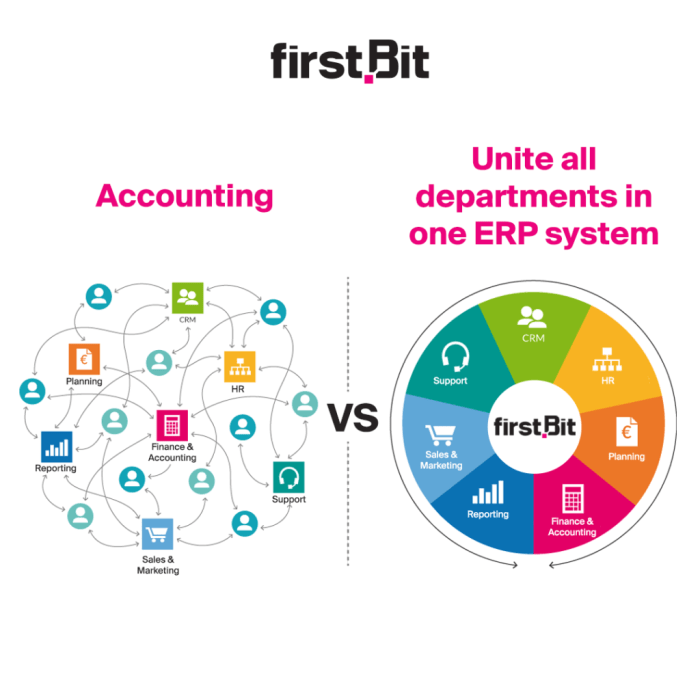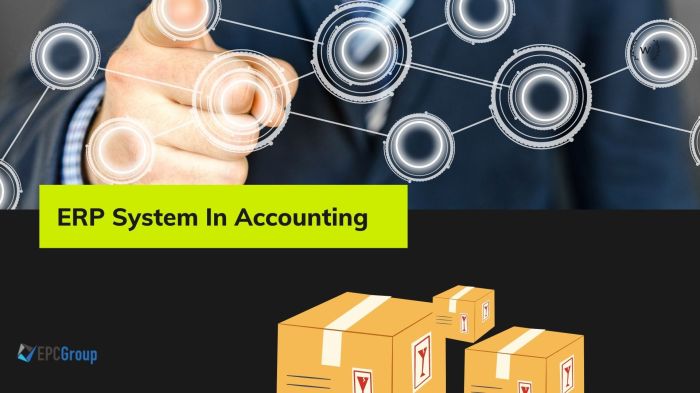How to integrate ERP software with existing accounting systems – Integrating ERP software with existing accounting systems can be a game-changer for businesses looking to streamline operations and improve efficiency. This process, however, requires careful planning and execution to ensure a seamless transition and maximize the benefits of this integration.
From understanding the various types of ERP software and their features to choosing the right system for your specific needs, this guide will walk you through the steps involved in integrating ERP software with your existing accounting systems. We’ll delve into data mapping and synchronization, explore different integration methods and tools, and discuss the importance of testing and ongoing maintenance.
Integration Methods and Tools

Successfully integrating ERP software with existing accounting systems is crucial for streamlined operations and data accuracy. The integration process involves connecting these systems, enabling data flow and synchronization. Various methods and tools can be employed, each with its advantages and disadvantages.
API Integration
API (Application Programming Interface) integration allows direct communication between the ERP and accounting systems. APIs act as intermediaries, enabling data exchange in a structured and standardized format. API integration offers several benefits:
- Real-time data synchronization: Changes in one system are reflected in the other instantly, ensuring data consistency.
- Flexibility and customization: APIs allow for tailored integrations to meet specific business needs.
- Scalability: API integrations can easily adapt to growing data volumes and system complexities.
However, API integration also presents challenges:
- Technical expertise: Implementing and maintaining API integrations requires technical skills.
- Cost: Developing and deploying API integrations can be expensive.
- Security concerns: Securely transmitting sensitive data through APIs is crucial.
Examples of popular API-based integration platforms include Zapier, Integromat, and Tray.io. These platforms offer pre-built integrations for various ERP and accounting software, simplifying the integration process.
Middleware Integration
Middleware acts as a bridge between the ERP and accounting systems, facilitating data exchange and transformation. Middleware solutions handle data mapping, validation, and routing, simplifying the integration process. Middleware integration offers advantages:
- Reduced development effort: Middleware solutions provide pre-built connectors and data transformation capabilities, minimizing custom development.
- Enhanced data quality: Middleware solutions can enforce data validation rules, ensuring data accuracy.
- Improved performance: Middleware can optimize data flow, enhancing integration speed.
However, middleware integration also has drawbacks:
- Complexity: Middleware solutions can be complex to configure and manage.
- Cost: Middleware solutions can be expensive, especially for complex integrations.
- Limited customization: Middleware solutions may not offer the same level of customization as API integrations.
Examples of popular middleware solutions include Dell Boomi, MuleSoft, and Informatica PowerCenter. These solutions offer pre-built connectors for various ERP and accounting systems, simplifying the integration process.
Custom Development
Custom development involves creating a unique integration solution tailored to specific business requirements. This method offers maximum flexibility and control over the integration process. Custom development offers advantages:
- Tailored solution: Custom integrations meet specific business needs and workflows.
- Complete control: Organizations have full control over the integration process and data flow.
- Enhanced functionality: Custom integrations can incorporate advanced features and functionalities.
However, custom development also presents challenges:
- High development costs: Custom development requires significant time and resources.
- Technical expertise: Custom development requires skilled developers with expertise in both ERP and accounting systems.
- Maintenance overhead: Maintaining custom integrations requires ongoing resources and expertise.
Custom development is typically suitable for complex integrations with unique requirements or for organizations with in-house development capabilities.
Choosing the Right Integration Method
The choice of integration method depends on factors such as:
- Integration complexity: For simple integrations, API integration or middleware might suffice. For complex integrations, custom development might be necessary.
- Budget: API integration is generally more cost-effective than custom development.
- Technical expertise: Organizations with limited technical expertise might benefit from middleware or pre-built API integrations.
- Data volume and frequency: High data volumes and frequent updates might require a robust integration solution like API integration or middleware.
- Security requirements: Secure data transmission is crucial, especially for sensitive data. API integration and middleware solutions offer built-in security features.
Testing and Validation: How To Integrate ERP Software With Existing Accounting Systems

Testing the integration of your ERP software with your existing accounting systems is crucial to ensure seamless data flow and accurate financial reporting. It involves verifying the accuracy and functionality of the integration process, ensuring that data is transferred correctly between systems, and identifying potential issues before the integration goes live.
Testing Plan
A comprehensive testing plan is essential for successful integration. This plan should cover various scenarios and data variations to thoroughly evaluate the integration’s performance.
- Data Accuracy and Completeness: Test the transfer of various data types, including financial transactions, customer information, and inventory details, to ensure accuracy and completeness.
- Functional Testing: Verify that all key functions, such as posting transactions, generating reports, and reconciling accounts, work as expected after the integration.
- Performance Testing: Evaluate the integration’s performance under different load conditions, including peak transaction volumes, to ensure it can handle real-world scenarios.
- Security Testing: Assess the security of the integration, including data encryption and access controls, to protect sensitive financial information.
- User Acceptance Testing (UAT): Involve end-users in testing the integration to ensure it meets their specific needs and workflows.
Test Scenarios
To design a comprehensive testing plan, consider different scenarios that simulate real-world use cases. These scenarios should cover a range of data variations and user actions.
- Data Entry: Test the integration’s ability to handle different data entry formats, including manual entries, automated imports, and API integrations.
- Data Updates: Test how the integration handles data updates, such as changes to customer information or inventory levels, and ensures consistency across systems.
- Data Reconciliation: Verify that the integration can reconcile data between the ERP and accounting systems, ensuring that balances match and transactions are accurately reflected in both systems.
- Reporting and Analytics: Test the ability to generate reports and perform analysis using integrated data, ensuring that the reports are accurate and provide valuable insights.
Test Result Documentation
Documenting test results is crucial for identifying potential issues and tracking progress.
- Test Case Documentation: Create detailed documentation for each test case, including the objective, steps involved, expected results, and actual results.
- Issue Tracking: Implement a system for tracking identified issues, including their severity, impact, and resolution status.
- Test Summary Report: Prepare a comprehensive test summary report that summarizes the testing process, results, and any outstanding issues.
Best Practices for Identifying Potential Issues
Identifying potential issues early in the integration process can prevent costly delays and ensure a smooth transition.
- Data Mapping and Validation: Carefully map and validate data fields between the ERP and accounting systems to ensure consistency and accuracy.
- Performance Monitoring: Monitor the integration’s performance during testing and after deployment to identify any bottlenecks or performance issues.
- User Feedback: Collect feedback from end-users throughout the testing process to identify any usability or workflow issues.
Ongoing Management and Maintenance

Once the ERP software is integrated with your existing accounting systems, the journey doesn’t end there. Ongoing management and maintenance are crucial for ensuring the seamless operation and effectiveness of the integrated system. This involves a proactive approach to address potential issues, optimize performance, and maintain data integrity.
Data Backups and Recovery
Regular data backups are essential for safeguarding your financial information and ensuring business continuity. Data loss can be catastrophic, disrupting operations and potentially leading to financial losses.
- Establish a comprehensive backup strategy that includes both regular incremental backups and full system backups.
- Implement a secure offsite backup solution to protect against physical damage or disasters at your primary location.
- Test your backup and recovery procedures regularly to ensure their effectiveness and identify any potential issues.
Security Updates and Patches
Cybersecurity threats are constantly evolving, making it essential to stay up-to-date with security updates and patches for both the ERP software and the accounting systems.
- Implement a robust security policy that includes strong passwords, multi-factor authentication, and access control measures.
- Regularly monitor for vulnerabilities and apply security updates promptly to mitigate risks.
- Consider using a security information and event management (SIEM) system to monitor for suspicious activity and potential breaches.
Performance Monitoring and Optimization
Monitoring the performance of the integrated systems is essential for identifying bottlenecks, optimizing resource utilization, and ensuring a smooth user experience.
- Establish key performance indicators (KPIs) to track metrics such as transaction processing times, system response times, and data load times.
- Use performance monitoring tools to gather real-time data and identify potential performance issues.
- Regularly review system logs and performance reports to identify areas for optimization and improvement.
User Training and Support, How to integrate ERP software with existing accounting systems
Effective user training is crucial for maximizing the benefits of the integrated system. Providing ongoing support to users can address any questions or issues they may encounter.
- Develop comprehensive user training programs that cover all aspects of the integrated system.
- Offer ongoing support through FAQs, documentation, user forums, or dedicated help desks.
- Regularly assess user feedback and make adjustments to training materials or support resources as needed.
Potential Challenges and Solutions
Despite careful planning and implementation, challenges may arise after the integration. It’s essential to be prepared to address these issues effectively.
- Data inconsistencies: Data discrepancies between the ERP and accounting systems can lead to inaccurate reporting and decision-making.
Solution: Implement data validation rules, data cleansing processes, and regular data reconciliation to ensure consistency.
- Integration issues: Unexpected errors or bugs can arise in the integration process, disrupting system functionality.
Solution: Maintain a detailed log of integration activities, establish clear communication channels between IT teams, and have a plan for troubleshooting and resolving issues promptly.
- User adoption: Resistance to change or difficulty adapting to new processes can hinder the success of the integration.
Solution: Provide comprehensive user training, address user concerns openly, and encourage feedback to foster a positive adoption experience.
By carefully considering the factors Artikeld in this guide, businesses can successfully integrate ERP software with their existing accounting systems, unlocking a wealth of benefits, including improved data accuracy, enhanced financial reporting, and greater operational efficiency. The key is to choose the right approach, plan meticulously, and manage the integration process effectively to ensure a smooth transition and reap the rewards of a fully integrated system.
Questions Often Asked
What are the common challenges associated with integrating ERP software with existing accounting systems?
Common challenges include data migration issues, system compatibility problems, integration complexity, and the need for extensive training and support.
What are the key factors to consider when selecting an ERP system for integration?
Key factors include scalability, functionality, compatibility with existing systems, cost, and vendor support.
How can I ensure data integrity during the integration process?
Data integrity can be ensured by performing thorough data mapping, validating data during the migration process, and implementing data quality checks.